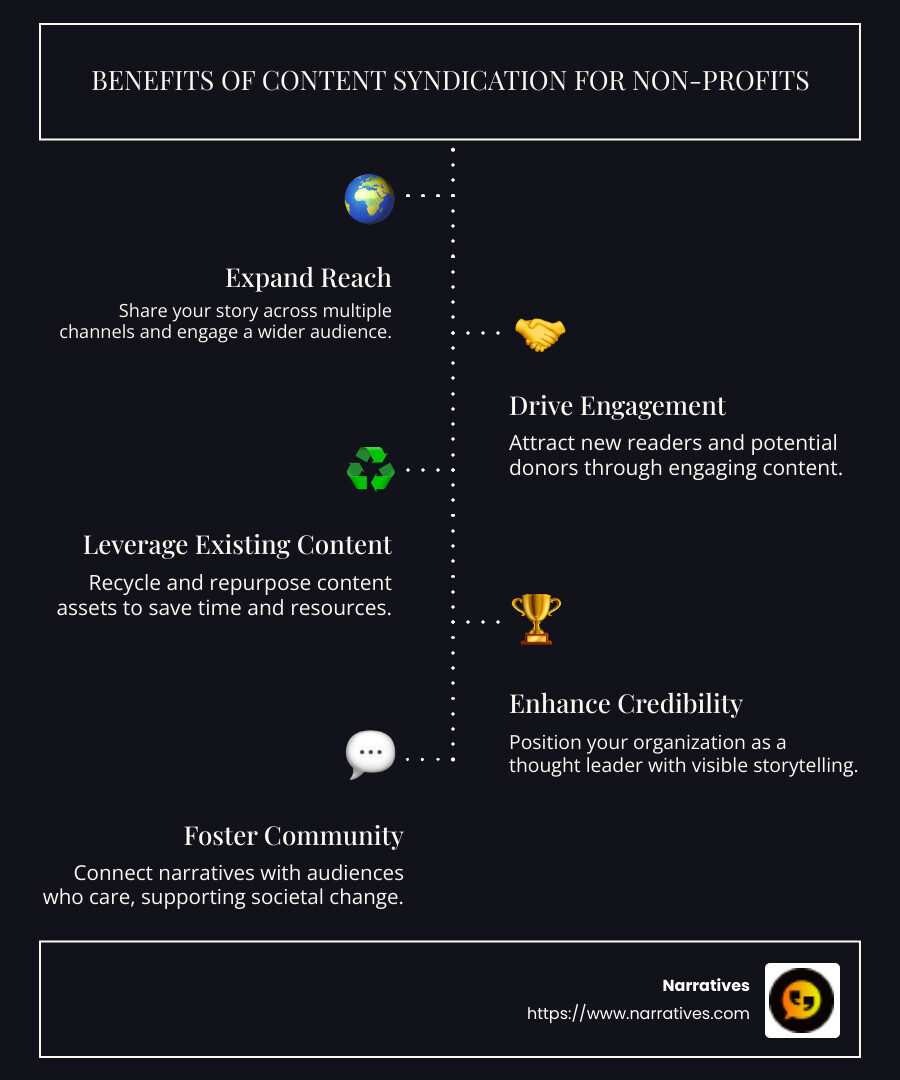Content Syndication Unleashed: Strategies to Amplify Your Reach

Content syndication strategy is a game-changer for non-profits and mission-driven organizations looking to broaden their reach and impact. By republishing your content on external platforms, you can reach new audiences, boost awareness, and drive tangible results like donations and community growth. Here's a quick look at the core benefits and approaches of content syndication:
- Expand Reach: Share your story across multiple channels and engage with a wider audience.
- Drive Engagement: Attract new readers and potential donors with relevant, place-focused content.
- Leverage Existing Content: Recycle and repurpose content assets to save time and resources.
- Improve Credibility: Position your organization as a thought leader through consistent and visible storytelling.
In the busy cities like New York, Chicago, and San Francisco, non-profits are constantly pushing for change. But sharing these significant stories far and wide can be challenging, especially when internal resources are tight. Content syndication offers a scalable solution. It helps you connect narratives that matter with the audiences who care.
Your stories deserve to be heard, supporting causes that drive societal change. Whether you're striving for environmental justice or advancing DEI initiatives, content syndication can magnify your voice and foster a sense of community around your mission.

Learn more about content syndication strategy:
Understanding Content Syndication
Content syndication is like giving your content a second life. Imagine you've spent hours crafting a compelling story or informative piece. Instead of letting it gather dust on your website, you can share it on third-party websites to reach a wider audience. This process of content distribution is both strategic and efficient.
Content Distribution
At its core, content syndication is about distributing your digital content beyond your own platform. It's like having your own content ambassadors who help spread your message. By republishing your articles, infographics, or videos on other websites, you can tap into new reader bases. This boosts your visibility and can lead to more engagement and leads.
Third-Party Websites
Third-party websites are crucial in this strategy. They act as hosts for your content, bringing it to audiences you might not reach otherwise. Think of them as stages where your content can shine. By choosing the right platforms—ones that align with your mission and audience—you can ensure your message resonates with the right people. For non-profits, this means finding partners that share your values and goals.

Digital Recycling
Digital recycling is a smart way to maximize the value of your existing content. Just like recycling materials to create something new, you can repurpose your digital assets. This doesn't mean simply copying and pasting. Instead, it's about adapting your content for different platforms and audiences. This approach saves time and resources while keeping your message fresh and relevant.
By understanding and implementing these key aspects of content syndication, non-profits can amplify their reach and impact. It's about making the most of what you have and strategically sharing it with the world. This way, your important stories continue to inspire and drive change.
Content Syndication Strategy: Key Components
When crafting a content syndication strategy, focus on three key components: lead generation, gated content, and understanding your target audience. Let's explore each of these elements to see how they can amplify your reach and effectiveness.
Lead Generation
One of the primary goals of content syndication is to generate leads. This isn't just about getting more eyes on your content; it's about attracting the right eyes. By placing your content on third-party websites, you can reach new audiences who are interested in what you have to offer. This is a strategic way to build your leads list with individuals who are more likely to engage with your brand.
Gated Content
Gated content is a powerful tool in lead generation. By requiring users to provide their contact information to access valuable resources like e-books, whitepapers, or webinars, you can gather crucial data about potential leads. This approach not only helps you build a list of interested prospects but also ensures that those accessing your content are genuinely interested in what you have to offer. Gated content acts as a filter, allowing you to focus your efforts on high-quality leads.
Target Audience
Understanding your target audience is the backbone of any successful content syndication strategy. It's crucial to know who you're trying to reach and what they're interested in. This means defining specific job titles, industries, and even geographical locations that align with your ideal customer profile. By tailoring your content to meet the needs and interests of your target audience, you can ensure that your syndication efforts are not only reaching a wide audience but the right one.
To sum up, focusing on lead generation, utilizing gated content, and clearly defining your target audience are the key components that will make your content syndication strategy effective. By honing in on these elements, you can maximize your reach and turn your content into a powerful tool for growth.

Next, we will explore seven effective content syndication strategies that will take your efforts to the next level.
7 Effective Content Syndication Strategies
Create Gated Content
Gated content is a game-changer in lead generation. By offering e-books, whitepapers, and infographics behind a form, you can collect valuable contact information. This method ensures that only genuinely interested users access your content, making them high-quality leads. Gated content acts as a magnet, drawing in those eager to learn more about your offerings.
Work with Niche Platforms
Partnering with niche platforms like ActualTech Media can significantly improve your content syndication efforts. These platforms specialize in specific industries or audiences, such as technology vendors. By aligning with a platform that understands your business, you can effectively reach your target audience. This targeted approach ensures your content is seen by the right people, increasing the likelihood of engagement and lead conversion.
Establish Filters
Before distributing your content, it's crucial to set filters based on job titles, industries, and locations. This helps you zero in on your ideal customers, ensuring that your content reaches those with the highest buying intent. By focusing on specific criteria, you can avoid wasting resources on uninterested audiences and instead concentrate on nurturing valuable leads.
Create Easy-to-Digest Content
In today's world, readers prefer content that is short and easy to digest. Create videos, infographics, and concise e-books that convey your message quickly and effectively. Short content is more likely to be consumed and shared, increasing your brand's reach and impact.
Make Your Asset Unique and Memorable
To stand out, your content must be unique and memorable. Use distinctive colors, authoritative tones, and engaging designs to make your digital assets unforgettable. A strong brand impact ensures that when your audience encounters your name later, they instantly recall the valuable content they accessed.
Clean Your Lead List
Data expiration is a common issue in lead management. Regularly cleaning your lead list is essential to ensure you're working with accurate and up-to-date information. Quality content syndication services often clean leads for you, ensuring they are fresh and ready for nurturing. This way, you only invest time and resources in viable prospects.
Nurture Your Leads
Lead nurturing is the cornerstone of a successful content syndication strategy. Use email drip campaigns and follow-up communications to build relationships with your leads. This approach keeps your brand top-of-mind and gradually guides prospects toward a purchase decision. Most leads aren't ready to buy immediately. Nurturing them effectively can turn potential interest into loyal customers.
By implementing these seven strategies, you can significantly amplify your content syndication efforts, ensuring your content not only reaches a wider audience but also converts into meaningful engagement and business growth.
Content Syndication and SEO
When it comes to content syndication strategy, understanding its impact on SEO is crucial. While syndication can boost your reach, it can also pose challenges, particularly concerning duplicate content, backlinks, and overall SEO performance.
SEO Impact
Content syndication can improve your visibility by placing your material on high-traffic third-party websites. This increased exposure can drive more visitors to your site, potentially boosting your organic traffic. However, the real SEO magic lies in how you manage duplicate content and backlinks.
Duplicate Content
One of the biggest concerns with content syndication is duplicate content. Search engines like Google prefer unique content. When the same piece appears on multiple sites, Google may choose to index the version on a larger, more authoritative site, possibly sidelining your original content.
To mitigate this, use canonical links. These links tell search engines which version of the content is the original. By coordinating with your syndication partners to implement canonical links, you ensure that your site receives the SEO credit it deserves.
Backlinks
Backlinks are another critical aspect of content syndication. When a third-party site republishes your content, it should include links back to your original article. This practice not only drives referral traffic but also helps build your site's authority.
Strong backlinks from reputable sites signal to search engines that your content is valuable and trustworthy. A robust backlink profile can improve your search rankings, enhancing your online presence.
Tools for Monitoring
To keep track of your SEO performance, tools like Google Analytics and Google Search Console are invaluable. Google Analytics helps you monitor referral traffic from syndication partners, while Google Search Console allows you to track indexing issues and verify canonical tag implementation.
By being proactive about these elements, you can leverage content syndication to boost your SEO, ensuring that your efforts translate into tangible results.
Next, we'll dive into some frequently asked questions about content syndication strategies to further clarify this powerful tool.
Frequently Asked Questions about Content Syndication Strategy
What exactly is content syndication?
Content syndication is the process of republishing your existing content, like blog posts, videos, or case studies, on third-party websites. This strategy helps you reach larger audiences without creating new content from scratch. It's like giving your top-performing content a second life, boosting visibility and brand awareness.
The magic of content syndication lies in its ability to distribute content across multiple platforms, providing fresh information to new readers. It’s a win-win: the syndicating site gets quality content, and you get more eyes on your work.
How does content syndication benefit SEO?
Content syndication can be a powerful ally for SEO when done right. Here's how:
Increased Visibility: By appearing on high-traffic sites, your content gains more exposure, potentially driving more organic traffic to your site.
Backlinks: When third-party sites republish your content, they should link back to your original article. These backlinks can improve your site's authority, signaling to search engines that your content is valuable.
Avoiding Duplicate Content Issues: Use canonical links to indicate which version of the content is the original. This practice helps ensure that search engines give your site the SEO credit it deserves.
What are the best practices for content syndication?
To make the most of your content syndication strategy, follow these best practices:
Foster Relationships with Partners: Build long-term relationships with syndication partners. This helps you maintain a consistent presence on their networks and attract more readers.
Avoid Duplicate Content Issues: Always use canonical links and ensure syndicated posts link back to your website. This helps search engines recognize your original content.
Tailor Content for Different Audiences: Customize your content to fit the audience of each syndication partner. This approach helps you connect better with their readers and drive more traffic to your site.
Add Relevant Links and CTAs: Encourage readers to visit your site by including clear calls to action and links to your original content.
Implement SEO Best Practices: Ensure your syndicated content follows SEO guidelines. Use headings, optimize for keywords, and include images with alt texts.
By adhering to these practices, you can maximize the benefits of content syndication, enhancing both your reach and SEO performance.
Next, we'll explore how Narratives can leverage these strategies to amplify their storytelling and partnership efforts.
Conclusion
At Narratives, we believe that content syndication is more than just a marketing tactic—it's a tool for change. Our mission is to empower non-profits and purpose-driven organizations to tell their stories in compelling ways. By leveraging content syndication strategies, we help these organizations amplify their reach and make a greater impact.
Non-Profit Partnerships and Storytelling Strategy
Our approach centers around forming strong partnerships with non-profits. We understand that these organizations often have powerful stories to tell but may lack the resources to reach wider audiences. Through content syndication, we ensure their voices are heard across various platforms, enhancing visibility and engagement.
Elevating Underrepresented Voices
Content syndication allows us to lift underrepresented voices by sharing their stories on high-traffic platforms. This not only increases awareness but also fosters a sense of community and support for their causes. By doing so, we help build trust and inspire action among new audiences.
Crafting Emotionally Resonant Content
In our storytelling strategy, we focus on creating emotionally resonant content that connects with audiences on a deeper level. Whether it's through videos, infographics, or case studies, our goal is to convey the impact of our partners' work and drive meaningful engagement.
Driving Long-Term Success
By integrating content syndication into our strategy, we aim to establish long-term success for the non-profits we partner with. This involves continuously adapting our approach to ensure the content remains relevant, engaging, and impactful.
Ready to explore how content syndication can amplify your organization's reach and storytelling efforts? Learn more about how Narratives can partner with you to share your impact stories with the world. Together, we can make a difference.


